Mathematics for IT: Exploring Trigonometry, Geometry & Complex No.
VerifiedAdded on 2023/06/07
|19
|2062
|361
Homework Assignment
AI Summary
This assignment solution focuses on fundamental mathematical concepts crucial for IT professionals. It includes detailed solutions for trigonometric functions, covering angles, applications, and real numbers. Coordinate geometry in two and three dimensions is explored, along with complex numbers and their various forms (polar, trigonometric, and exponential). The assignment also addresses matrix operations and vector algebra, providing step-by-step calculations and explanations. References to relevant academic resources are included, making this a comprehensive guide for students studying mathematics for IT. Desklib provides a platform where students can access similar past papers and solved assignments.
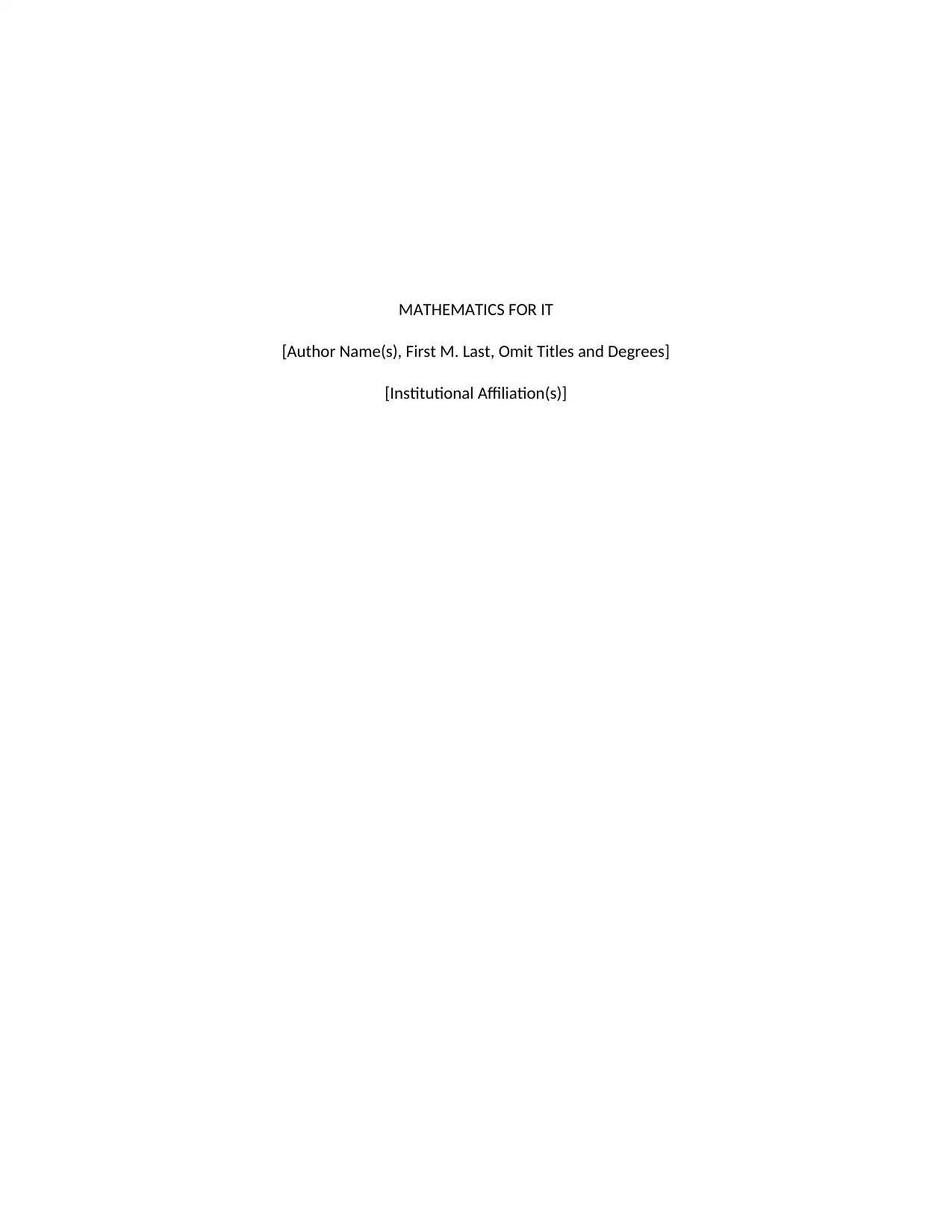
MATHEMATICS FOR IT
[Author Name(s), First M. Last, Omit Titles and Degrees]
[Institutional Affiliation(s)]
[Author Name(s), First M. Last, Omit Titles and Degrees]
[Institutional Affiliation(s)]
Paraphrase This Document
Need a fresh take? Get an instant paraphrase of this document with our AI Paraphraser
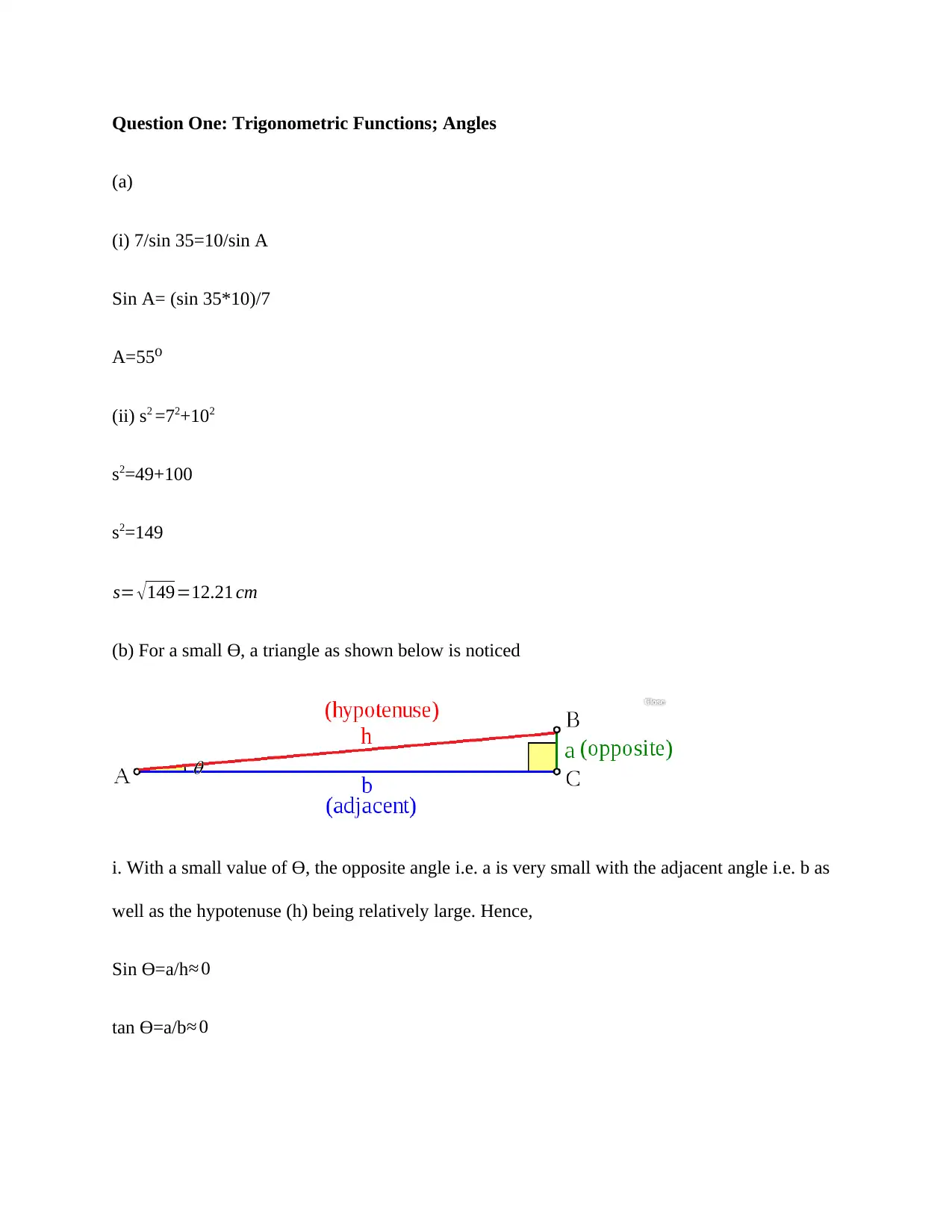
Question One: Trigonometric Functions; Angles
(a)
(i) 7/sin 35=10/sin A
Sin A= (sin 35*10)/7
A=55⁰
(ii) s2 =72+102
s2=49+100
s2=149
s= √ 149=12.21 cm
(b) For a small Ɵ, a triangle as shown below is noticed
i. With a small value of Ɵ, the opposite angle i.e. a is very small with the adjacent angle i.e. b as
well as the hypotenuse (h) being relatively large. Hence,
Sin Ɵ=a/h ≈ 0
tan Ɵ=a/b≈ 0
(a)
(i) 7/sin 35=10/sin A
Sin A= (sin 35*10)/7
A=55⁰
(ii) s2 =72+102
s2=49+100
s2=149
s= √ 149=12.21 cm
(b) For a small Ɵ, a triangle as shown below is noticed
i. With a small value of Ɵ, the opposite angle i.e. a is very small with the adjacent angle i.e. b as
well as the hypotenuse (h) being relatively large. Hence,
Sin Ɵ=a/h ≈ 0
tan Ɵ=a/b≈ 0
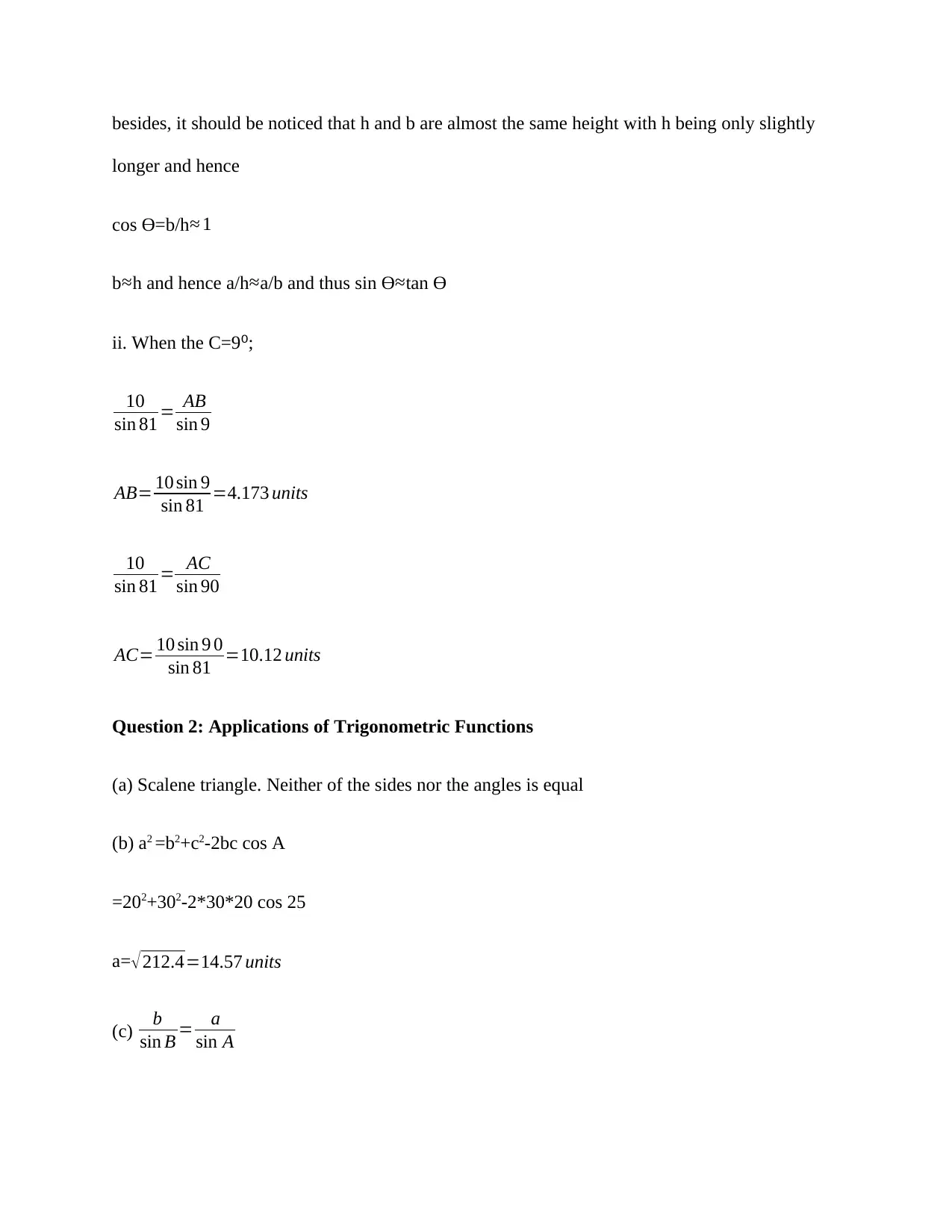
besides, it should be noticed that h and b are almost the same height with h being only slightly
longer and hence
cos Ɵ=b/h≈ 1
b≈h and hence a/h≈a/b and thus sin Ɵ≈tan Ɵ
ii. When the C=9⁰;
10
sin 81 = AB
sin 9
AB= 10 sin 9
sin 81 =4.173 units
10
sin 81 = AC
sin 90
AC= 10 sin 9 0
sin 81 =10.12 units
Question 2: Applications of Trigonometric Functions
(a) Scalene triangle. Neither of the sides nor the angles is equal
(b) a2 =b2+c2-2bc cos A
=202+302-2*30*20 cos 25
a=√212.4=14.57 units
(c) b
sin B = a
sin A
longer and hence
cos Ɵ=b/h≈ 1
b≈h and hence a/h≈a/b and thus sin Ɵ≈tan Ɵ
ii. When the C=9⁰;
10
sin 81 = AB
sin 9
AB= 10 sin 9
sin 81 =4.173 units
10
sin 81 = AC
sin 90
AC= 10 sin 9 0
sin 81 =10.12 units
Question 2: Applications of Trigonometric Functions
(a) Scalene triangle. Neither of the sides nor the angles is equal
(b) a2 =b2+c2-2bc cos A
=202+302-2*30*20 cos 25
a=√212.4=14.57 units
(c) b
sin B = a
sin A
⊘ This is a preview!⊘
Do you want full access?
Subscribe today to unlock all pages.

Trusted by 1+ million students worldwide

30
sin B = 14.57
sin 25
sin B= 30 sin 25
14.57 =0.871
B=60.57⁰
(d) c
sin C = a
sin A
30
sin C = 14.57
sin 25
sin C= 20sin 25
14.57 =0.581
C=35.52⁰
(e) Area of the triangle
A= √s (s−a)(s−b)( s−c)
S=p/2= (20+30+14.57)/2=32.3
A= √ 32.3 (32.3−30)(32.3−20)(32.3−14.57)
√ 32.3× 2.3 ×12.3 ×17.73=127.28 sq. units
Question 3: Trigonometric Functions of Real Numbers
(a)
sin B = 14.57
sin 25
sin B= 30 sin 25
14.57 =0.871
B=60.57⁰
(d) c
sin C = a
sin A
30
sin C = 14.57
sin 25
sin C= 20sin 25
14.57 =0.581
C=35.52⁰
(e) Area of the triangle
A= √s (s−a)(s−b)( s−c)
S=p/2= (20+30+14.57)/2=32.3
A= √ 32.3 (32.3−30)(32.3−20)(32.3−14.57)
√ 32.3× 2.3 ×12.3 ×17.73=127.28 sq. units
Question 3: Trigonometric Functions of Real Numbers
(a)
Paraphrase This Document
Need a fresh take? Get an instant paraphrase of this document with our AI Paraphraser
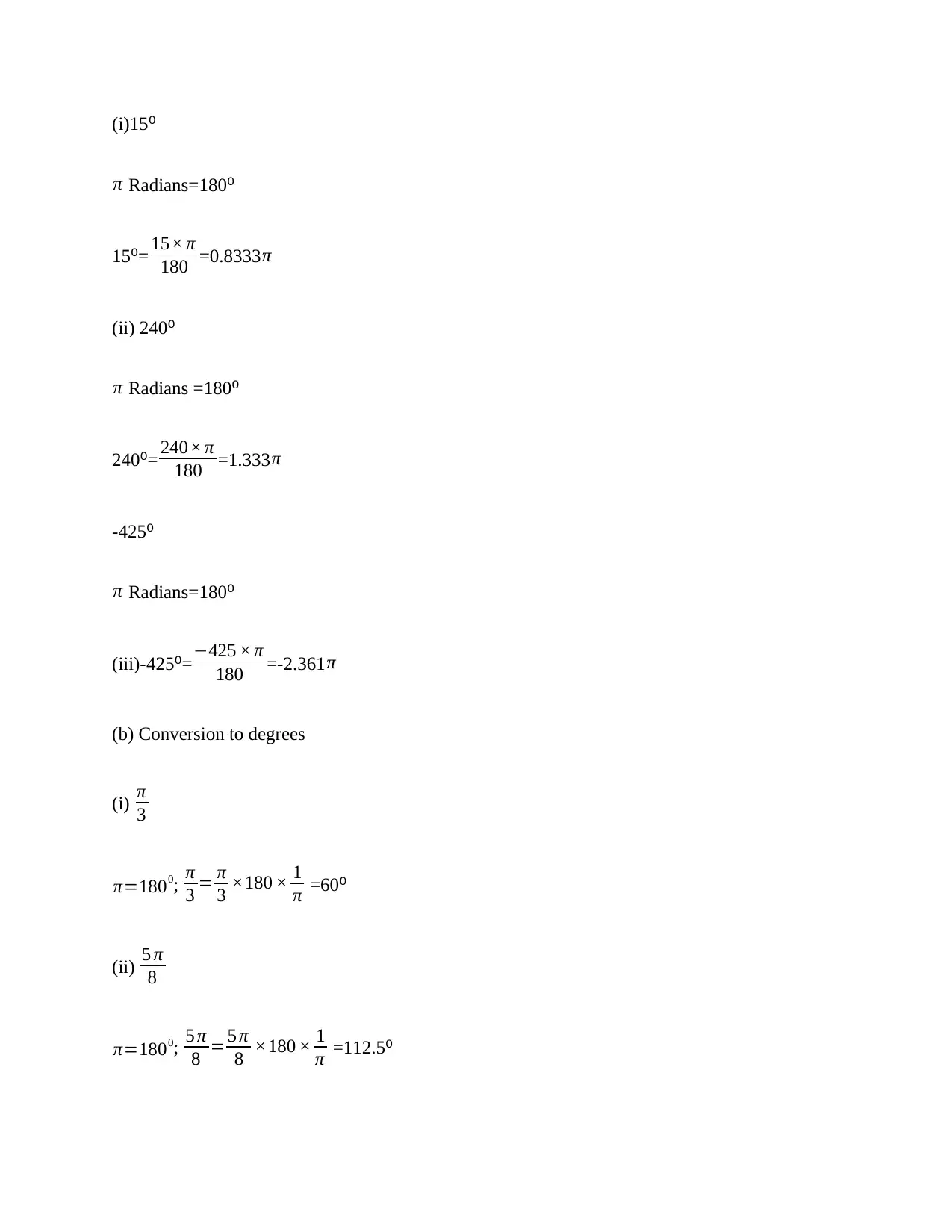
(i)15⁰
π Radians=180⁰
15⁰= 15× π
180 =0.8333 π
(ii) 240⁰
π Radians =180⁰
240⁰= 240× π
180 =1.333 π
-425⁰
π Radians=180⁰
(iii)-425⁰=−425 × π
180 =-2.361π
(b) Conversion to degrees
(i) π
3
π=1800; π
3 = π
3 ×180 × 1
π =60⁰
(ii) 5 π
8
π=1800; 5 π
8 = 5 π
8 ×180 × 1
π =112.5⁰
π Radians=180⁰
15⁰= 15× π
180 =0.8333 π
(ii) 240⁰
π Radians =180⁰
240⁰= 240× π
180 =1.333 π
-425⁰
π Radians=180⁰
(iii)-425⁰=−425 × π
180 =-2.361π
(b) Conversion to degrees
(i) π
3
π=1800; π
3 = π
3 ×180 × 1
π =60⁰
(ii) 5 π
8
π=1800; 5 π
8 = 5 π
8 ×180 × 1
π =112.5⁰
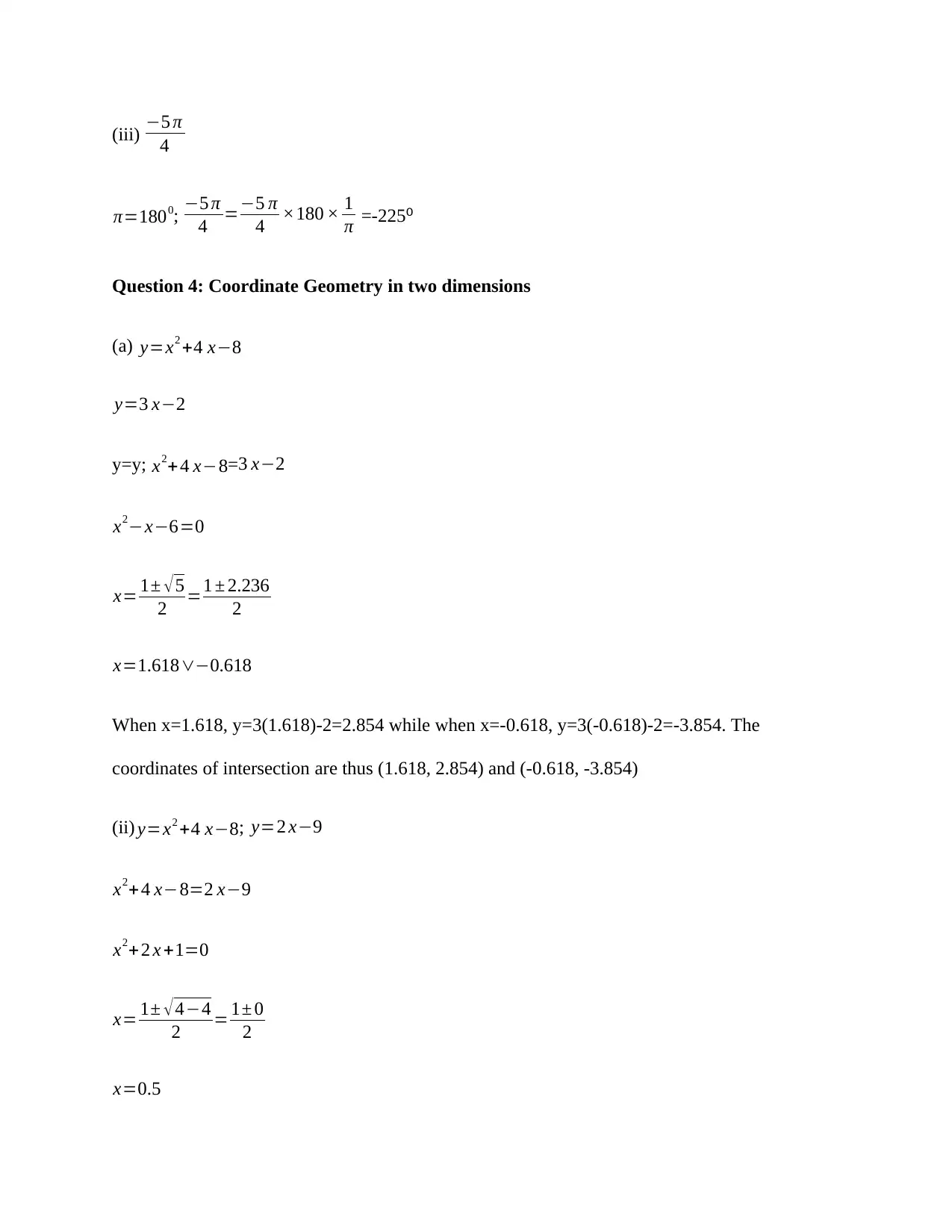
(iii) −5 π
4
π=1800; −5 π
4 =−5 π
4 ×180 × 1
π =-225⁰
Question 4: Coordinate Geometry in two dimensions
(a) y=x2 +4 x−8
y=3 x−2
y=y; x2+4 x−8=3 x−2
x2−x−6=0
x= 1± √ 5
2 =1 ± 2.236
2
x=1.618∨−0.618
When x=1.618, y=3(1.618)-2=2.854 while when x=-0.618, y=3(-0.618)-2=-3.854. The
coordinates of intersection are thus (1.618, 2.854) and (-0.618, -3.854)
(ii) y=x2 +4 x−8; y=2 x−9
x2+ 4 x−8=2 x−9
x2+ 2 x +1=0
x= 1± √4−4
2 = 1± 0
2
x=0.5
4
π=1800; −5 π
4 =−5 π
4 ×180 × 1
π =-225⁰
Question 4: Coordinate Geometry in two dimensions
(a) y=x2 +4 x−8
y=3 x−2
y=y; x2+4 x−8=3 x−2
x2−x−6=0
x= 1± √ 5
2 =1 ± 2.236
2
x=1.618∨−0.618
When x=1.618, y=3(1.618)-2=2.854 while when x=-0.618, y=3(-0.618)-2=-3.854. The
coordinates of intersection are thus (1.618, 2.854) and (-0.618, -3.854)
(ii) y=x2 +4 x−8; y=2 x−9
x2+ 4 x−8=2 x−9
x2+ 2 x +1=0
x= 1± √4−4
2 = 1± 0
2
x=0.5
⊘ This is a preview!⊘
Do you want full access?
Subscribe today to unlock all pages.

Trusted by 1+ million students worldwide
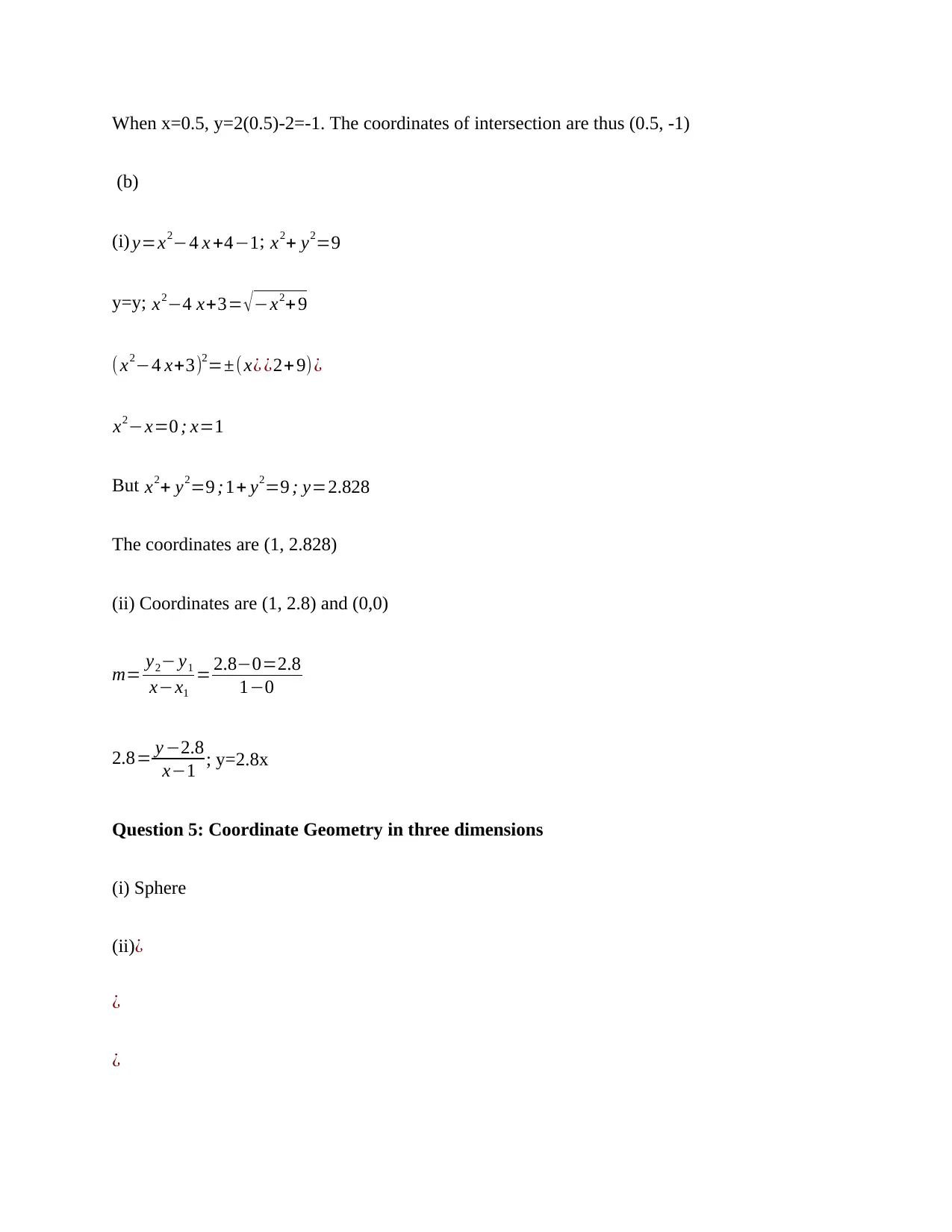
When x=0.5, y=2(0.5)-2=-1. The coordinates of intersection are thus (0.5, -1)
(b)
(i) y=x2−4 x +4−1; x2+ y2=9
y=y; x2−4 x+3= √ −x2+ 9
(x2−4 x+3)2=±(x¿ ¿2+ 9)¿
x2−x=0 ; x=1
But x2+ y2=9 ;1+ y2=9 ; y=2.828
The coordinates are (1, 2.828)
(ii) Coordinates are (1, 2.8) and (0,0)
m= y2− y1
x−x1
= 2.8−0=2.8
1−0
2.8= y −2.8
x−1 ; y=2.8x
Question 5: Coordinate Geometry in three dimensions
(i) Sphere
(ii)¿
¿
¿
(b)
(i) y=x2−4 x +4−1; x2+ y2=9
y=y; x2−4 x+3= √ −x2+ 9
(x2−4 x+3)2=±(x¿ ¿2+ 9)¿
x2−x=0 ; x=1
But x2+ y2=9 ;1+ y2=9 ; y=2.828
The coordinates are (1, 2.828)
(ii) Coordinates are (1, 2.8) and (0,0)
m= y2− y1
x−x1
= 2.8−0=2.8
1−0
2.8= y −2.8
x−1 ; y=2.8x
Question 5: Coordinate Geometry in three dimensions
(i) Sphere
(ii)¿
¿
¿
Paraphrase This Document
Need a fresh take? Get an instant paraphrase of this document with our AI Paraphraser
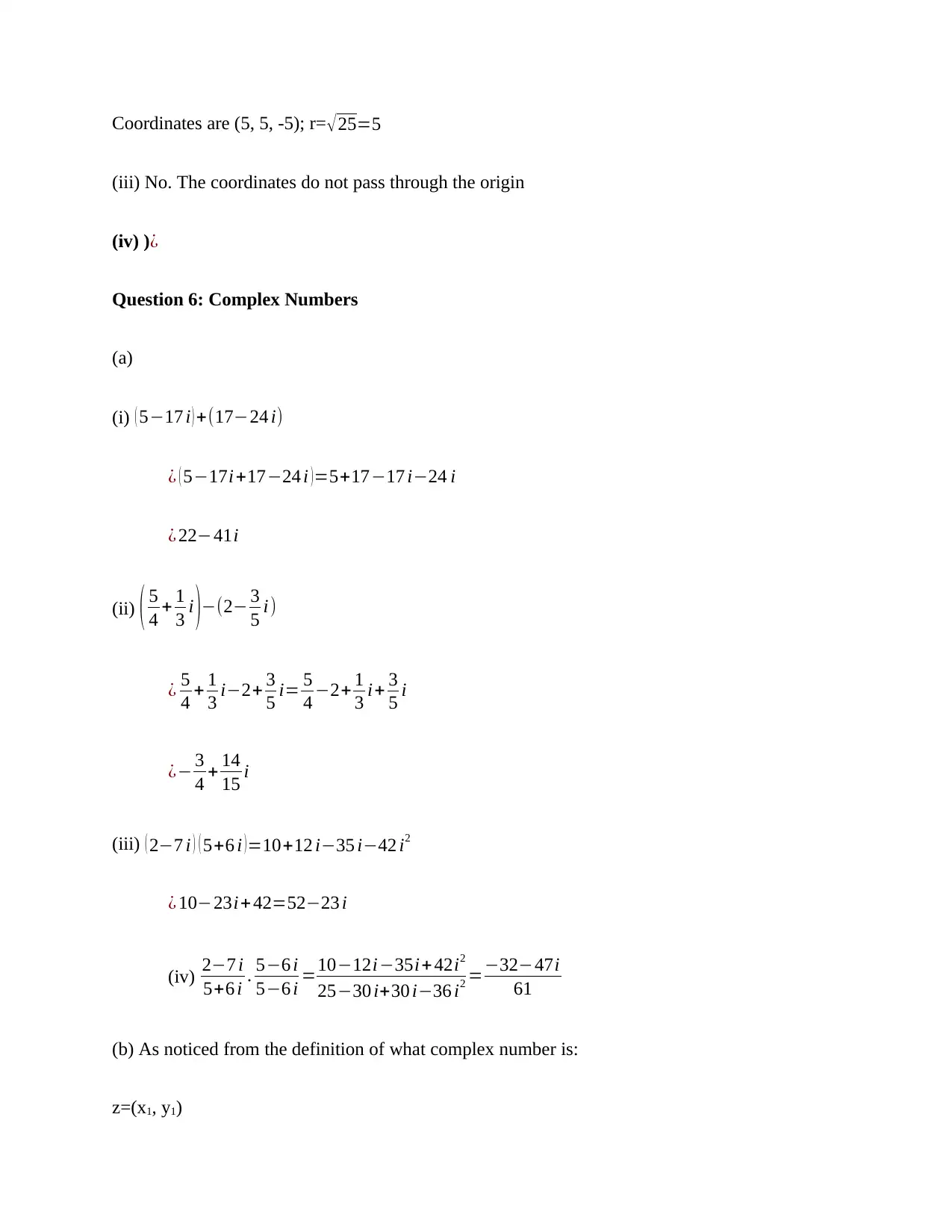
Coordinates are (5, 5, -5); r= √25=5
(iii) No. The coordinates do not pass through the origin
(iv) )¿
Question 6: Complex Numbers
(a)
(i) ( 5−17 i ) +(17−24 i)
¿ ( 5−17i+17−24 i ) =5+17−17 i−24 i
¿ 22−41i
(ii) ( 5
4 + 1
3 i )−(2− 3
5 i)
¿ 5
4 + 1
3 i−2+ 3
5 i= 5
4 −2+ 1
3 i+ 3
5 i
¿− 3
4 + 14
15 i
(iii) ( 2−7 i ) ( 5+6 i ) =10+12 i−35 i−42 i2
¿ 10−23i+ 42=52−23 i
(iv) 2−7 i
5+6 i . 5−6 i
5−6 i =10−12i−35i+ 42i2
25−30 i+30 i−36 i2 =−32−47i
61
(b) As noticed from the definition of what complex number is:
z=(x1, y1)
(iii) No. The coordinates do not pass through the origin
(iv) )¿
Question 6: Complex Numbers
(a)
(i) ( 5−17 i ) +(17−24 i)
¿ ( 5−17i+17−24 i ) =5+17−17 i−24 i
¿ 22−41i
(ii) ( 5
4 + 1
3 i )−(2− 3
5 i)
¿ 5
4 + 1
3 i−2+ 3
5 i= 5
4 −2+ 1
3 i+ 3
5 i
¿− 3
4 + 14
15 i
(iii) ( 2−7 i ) ( 5+6 i ) =10+12 i−35 i−42 i2
¿ 10−23i+ 42=52−23 i
(iv) 2−7 i
5+6 i . 5−6 i
5−6 i =10−12i−35i+ 42i2
25−30 i+30 i−36 i2 =−32−47i
61
(b) As noticed from the definition of what complex number is:
z=(x1, y1)
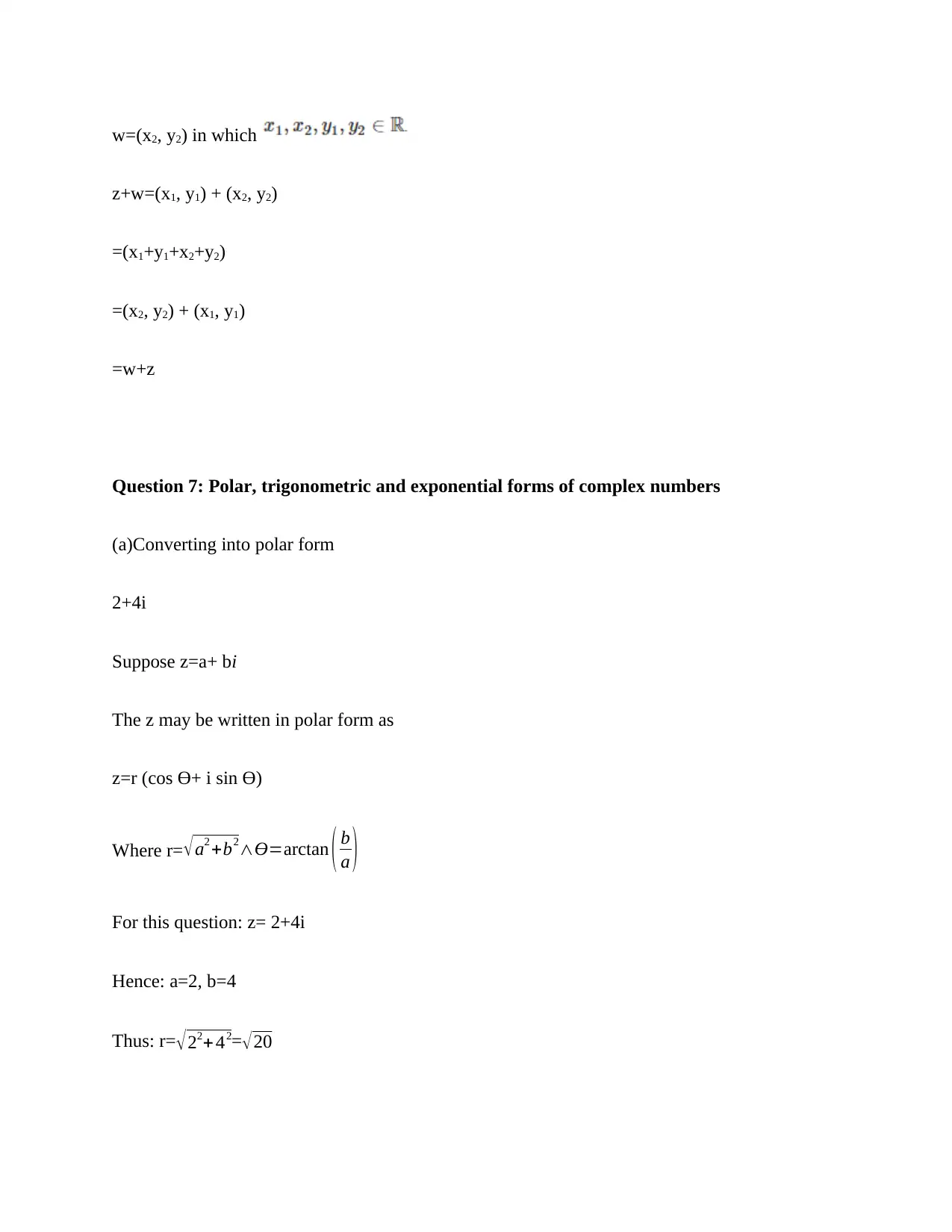
w=(x2, y2) in which
z+w=(x1, y1) + (x2, y2)
=(x1+y1+x2+y2)
=(x2, y2) + (x1, y1)
=w+z
Question 7: Polar, trigonometric and exponential forms of complex numbers
(a)Converting into polar form
2+4i
Suppose z=a+ bi
The z may be written in polar form as
z=r (cos Ɵ+ i sin Ɵ)
Where r= √a2 +b2∧Ɵ=arctan ( b
a )
For this question: z= 2+4i
Hence: a=2, b=4
Thus: r=√ 22+ 42=√20
z+w=(x1, y1) + (x2, y2)
=(x1+y1+x2+y2)
=(x2, y2) + (x1, y1)
=w+z
Question 7: Polar, trigonometric and exponential forms of complex numbers
(a)Converting into polar form
2+4i
Suppose z=a+ bi
The z may be written in polar form as
z=r (cos Ɵ+ i sin Ɵ)
Where r= √a2 +b2∧Ɵ=arctan ( b
a )
For this question: z= 2+4i
Hence: a=2, b=4
Thus: r=√ 22+ 42=√20
⊘ This is a preview!⊘
Do you want full access?
Subscribe today to unlock all pages.

Trusted by 1+ million students worldwide
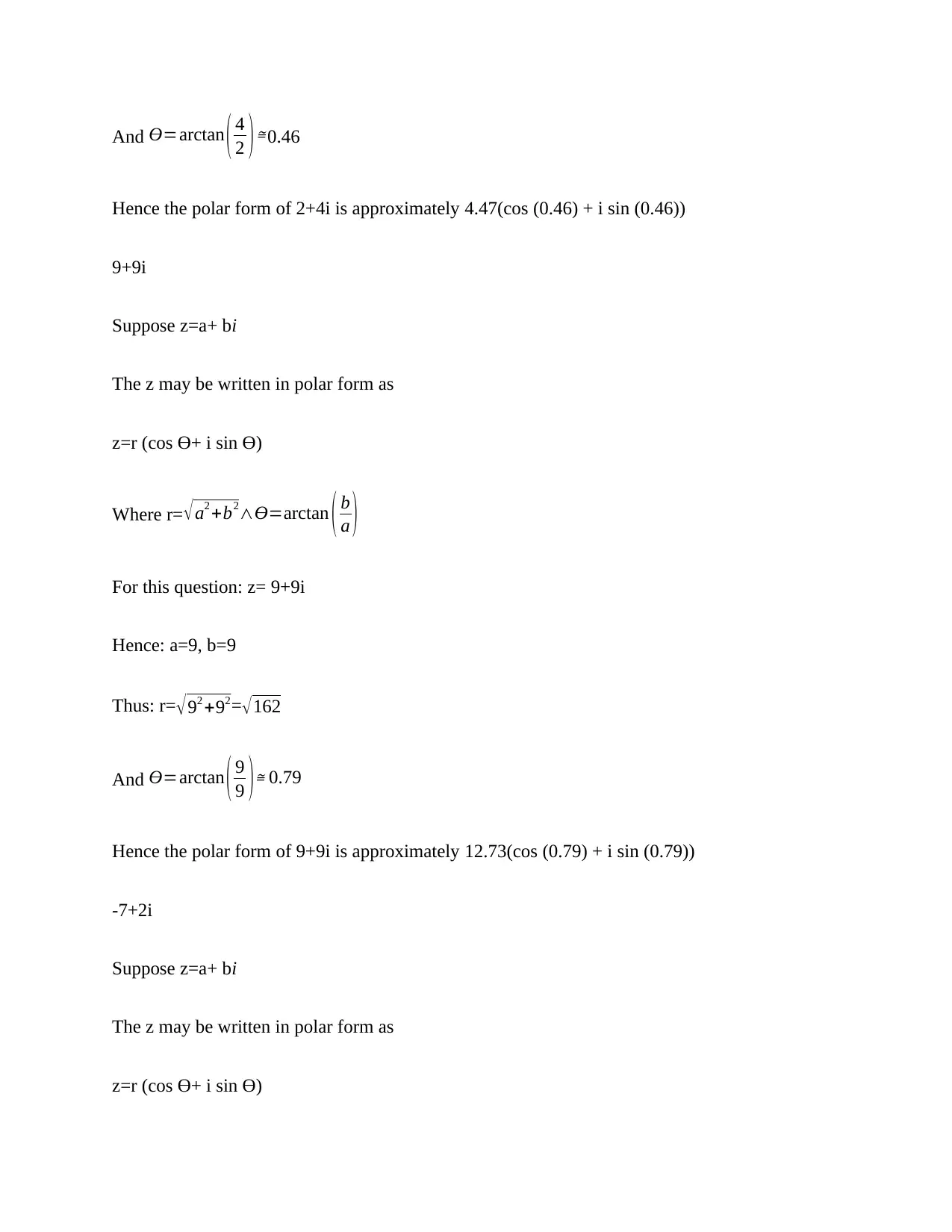
And Ɵ=arctan ( 4
2 )≅0.46
Hence the polar form of 2+4i is approximately 4.47(cos (0.46) + i sin (0.46))
9+9i
Suppose z=a+ bi
The z may be written in polar form as
z=r (cos Ɵ+ i sin Ɵ)
Where r= √a2 +b2∧Ɵ=arctan ( b
a )
For this question: z= 9+9i
Hence: a=9, b=9
Thus: r=√ 92 +92=√162
And Ɵ=arctan ( 9
9 )≅ 0.79
Hence the polar form of 9+9i is approximately 12.73(cos (0.79) + i sin (0.79))
-7+2i
Suppose z=a+ bi
The z may be written in polar form as
z=r (cos Ɵ+ i sin Ɵ)
2 )≅0.46
Hence the polar form of 2+4i is approximately 4.47(cos (0.46) + i sin (0.46))
9+9i
Suppose z=a+ bi
The z may be written in polar form as
z=r (cos Ɵ+ i sin Ɵ)
Where r= √a2 +b2∧Ɵ=arctan ( b
a )
For this question: z= 9+9i
Hence: a=9, b=9
Thus: r=√ 92 +92=√162
And Ɵ=arctan ( 9
9 )≅ 0.79
Hence the polar form of 9+9i is approximately 12.73(cos (0.79) + i sin (0.79))
-7+2i
Suppose z=a+ bi
The z may be written in polar form as
z=r (cos Ɵ+ i sin Ɵ)
Paraphrase This Document
Need a fresh take? Get an instant paraphrase of this document with our AI Paraphraser
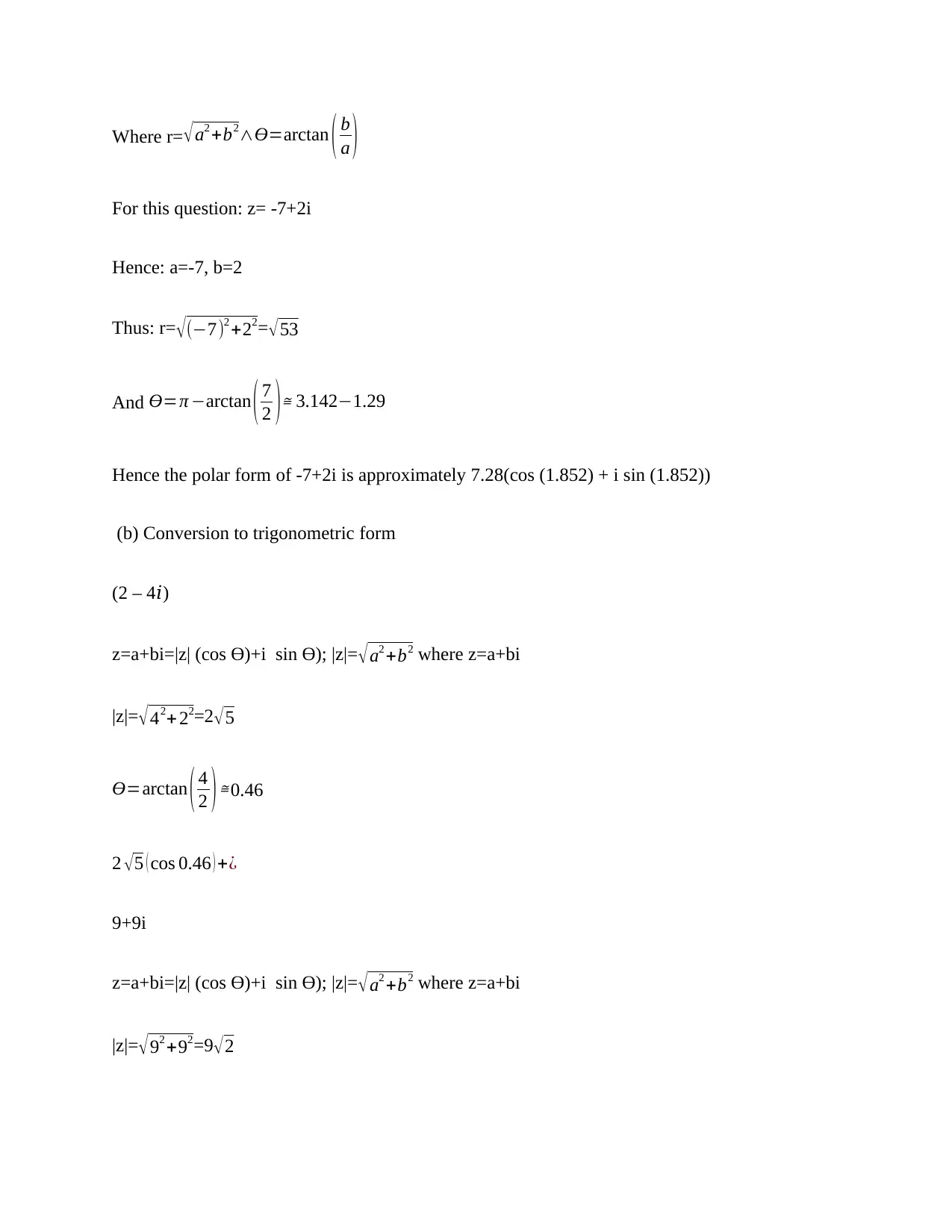
Where r= √a2 +b2∧Ɵ=arctan ( b
a )
For this question: z= -7+2i
Hence: a=-7, b=2
Thus: r=√ (−7)2 +22=√ 53
And Ɵ=π −arctan ( 7
2 )≅ 3.142−1.29
Hence the polar form of -7+2i is approximately 7.28(cos (1.852) + i sin (1.852))
(b) Conversion to trigonometric form
(2 – 4𝑖)
z=a+bi=|z| (cos Ɵ)+i sin Ɵ); |z|= √ a2 +b2 where z=a+bi
|z|=√ 42+ 22=2√5
Ɵ=arctan ( 4
2 )≅0.46
2 √ 5 ( cos 0.46 ) +¿
9+9i
z=a+bi=|z| (cos Ɵ)+i sin Ɵ); |z|= √ a2 +b2 where z=a+bi
|z|=√ 92 +92=9√2
a )
For this question: z= -7+2i
Hence: a=-7, b=2
Thus: r=√ (−7)2 +22=√ 53
And Ɵ=π −arctan ( 7
2 )≅ 3.142−1.29
Hence the polar form of -7+2i is approximately 7.28(cos (1.852) + i sin (1.852))
(b) Conversion to trigonometric form
(2 – 4𝑖)
z=a+bi=|z| (cos Ɵ)+i sin Ɵ); |z|= √ a2 +b2 where z=a+bi
|z|=√ 42+ 22=2√5
Ɵ=arctan ( 4
2 )≅0.46
2 √ 5 ( cos 0.46 ) +¿
9+9i
z=a+bi=|z| (cos Ɵ)+i sin Ɵ); |z|= √ a2 +b2 where z=a+bi
|z|=√ 92 +92=9√2
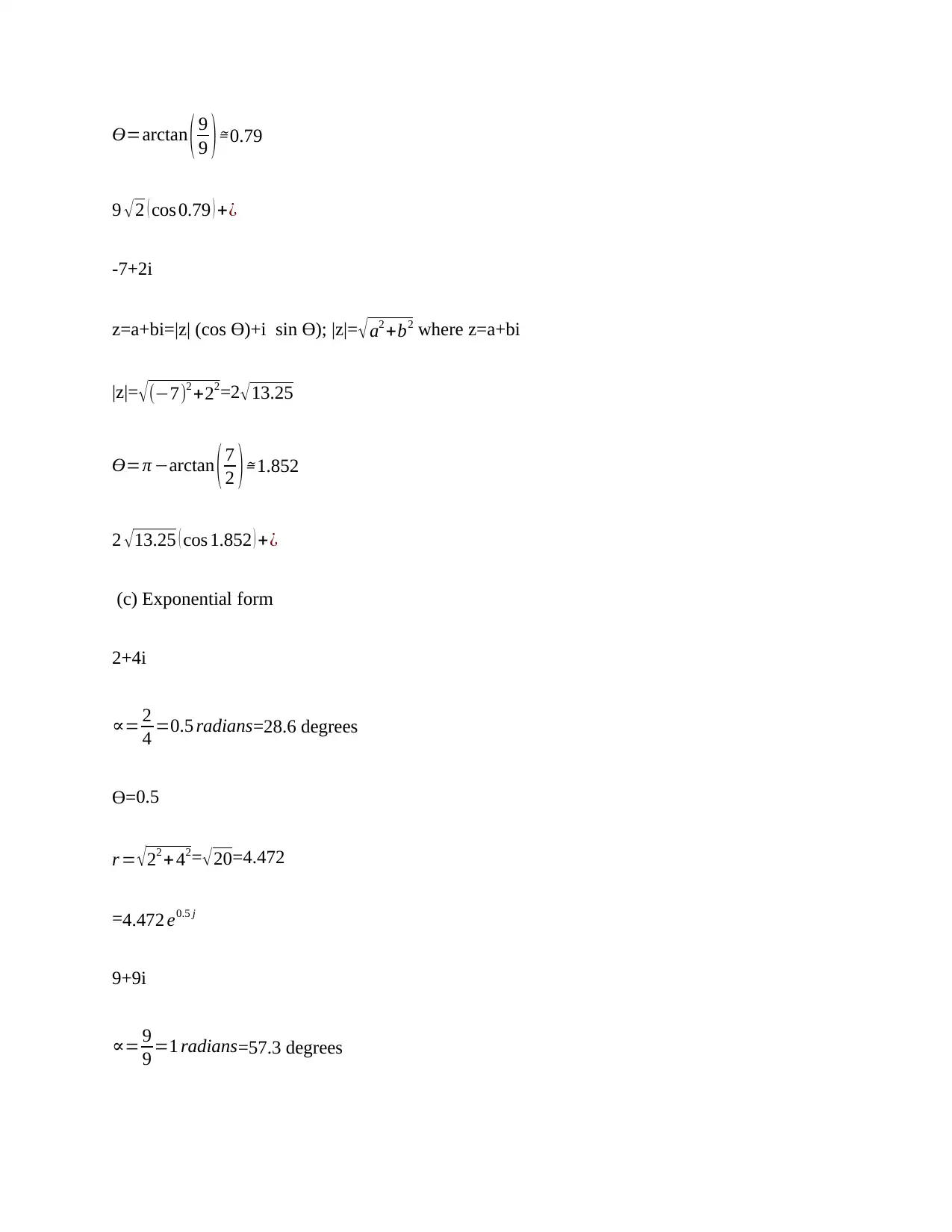
Ɵ=arctan ( 9
9 ) ≅0.79
9 √2 ( cos 0.79 ) +¿
-7+2i
z=a+bi=|z| (cos Ɵ)+i sin Ɵ); |z|= √ a2 +b2 where z=a+bi
|z|=√ (−7)2 +22=2√13.25
Ɵ=π −arctan ( 7
2 ) ≅ 1.852
2 √13.25 ( cos 1.852 ) +¿
(c) Exponential form
2+4i
∝= 2
4 =0.5 radians=28.6 degrees
Ɵ= 0.5
r = √22 +42=√20=4.472
=4.472 e0.5 j
9+9i
∝= 9
9 =1 radians=57.3 degrees
9 ) ≅0.79
9 √2 ( cos 0.79 ) +¿
-7+2i
z=a+bi=|z| (cos Ɵ)+i sin Ɵ); |z|= √ a2 +b2 where z=a+bi
|z|=√ (−7)2 +22=2√13.25
Ɵ=π −arctan ( 7
2 ) ≅ 1.852
2 √13.25 ( cos 1.852 ) +¿
(c) Exponential form
2+4i
∝= 2
4 =0.5 radians=28.6 degrees
Ɵ= 0.5
r = √22 +42=√20=4.472
=4.472 e0.5 j
9+9i
∝= 9
9 =1 radians=57.3 degrees
⊘ This is a preview!⊘
Do you want full access?
Subscribe today to unlock all pages.

Trusted by 1+ million students worldwide
1 out of 19
Related Documents
Your All-in-One AI-Powered Toolkit for Academic Success.
+13062052269
info@desklib.com
Available 24*7 on WhatsApp / Email
![[object Object]](/_next/static/media/star-bottom.7253800d.svg)
Unlock your academic potential
Copyright © 2020–2025 A2Z Services. All Rights Reserved. Developed and managed by ZUCOL.



